Table of Contents
As with many hobbies and professions, beekeepers do not need all of our equipment all of the time. When winter approaches and honey supers are removed from the hives, we are left with many valuable resources which need to be properly protected in storage over winter.
Drawn comb frames and honey residue can attract pests, and humidity can lead to mold growing in our equipment, all of which costs us time and resources heading into next spring. With proper care, we can avoid these expenses altogether and ensure ourselves a solid start for next spring right now.
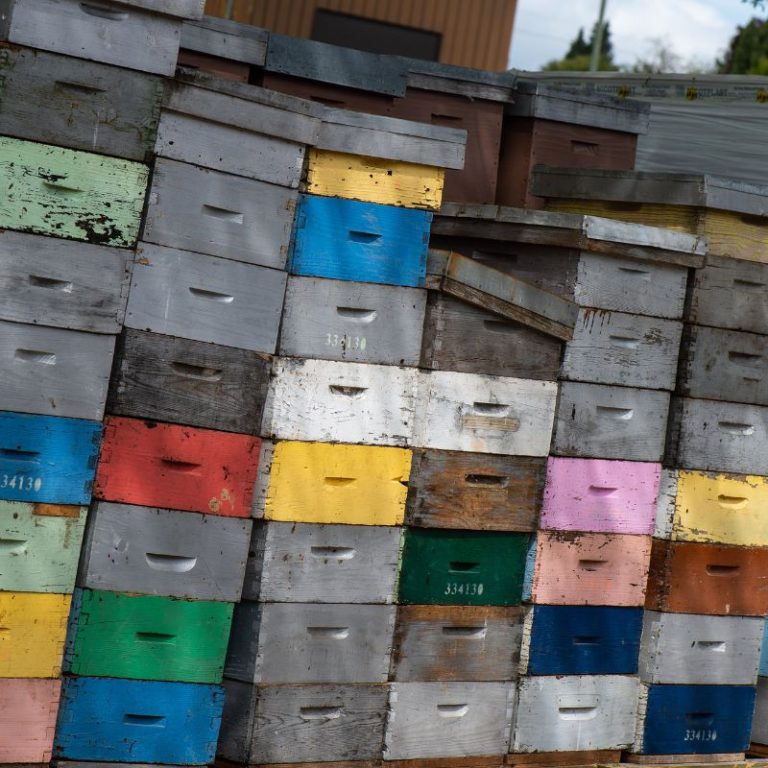
What Kind Of Beekeeping Equipment Needs To Be Stored?
Bee colony size swells in the spring with a significant population build-up to create the workforce needed to forage each spring and summer. While the brood box or boxes provide the space needed for your queen to lay and your workers to raise the young, if you want surplus honey, you must provide surplus space for it to be stored, like a super. Read our blog called “What Is A Super?”.
The honey supers you add for that space will always require storage for a good part of the year when they are not in use. When the bees are not making excess honey, the honey boxes and frames are stored.
You will need to make sure your colonies have adequate space for growth and for the storage of honey. If the colony does not have enough space in its current hive, the result could be a swarm, requiring a new box if you wish to capture it. Better to provide adequate space upfront and as it is needed.

Because of the fluctuating nature of the size of a honeybee colony, keeping bees will inevitably require excess equipment during any season (This is a good thing for the beekeeper). But during winter months, when your bees contract into a cluster, and you have removed your honey supers and put away your beekeeping suit, there can be a considerable amount of equipment that may need attention to maintain it for the next season.
Additionally, any time a colony dies, or if you combine a weaker colony with a stronger one, there will be excess brood boxes and brood comb, which will also require storage. Extra care should be taken with brood comb and boxes as these resources are particularly attractive to wax moths, and they are willing to go to greater lengths to access them. There is another pest called a small hive beetle, but they are mostly after actual honey instead of the comb.
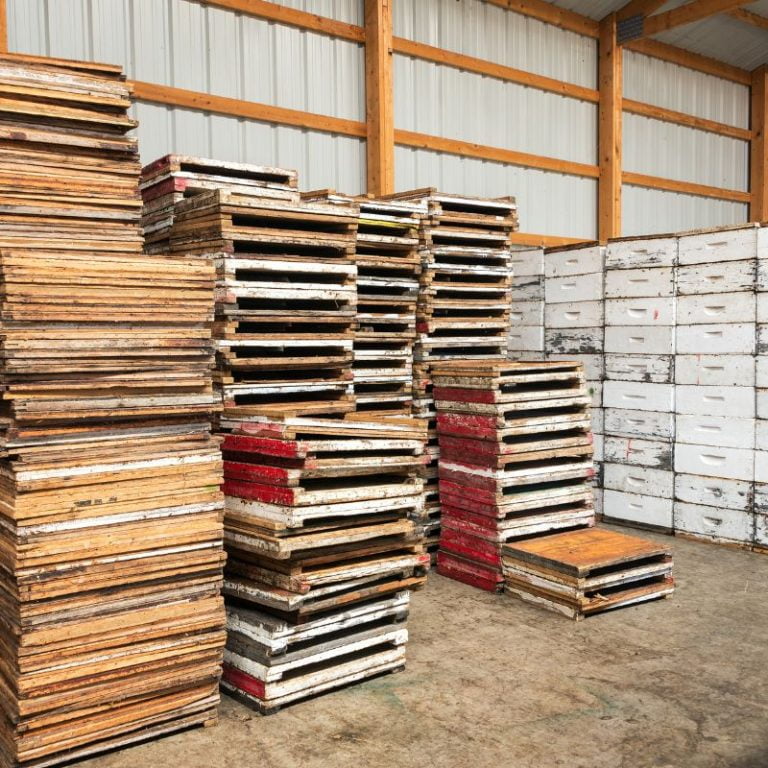
Beekeeping Equipment To Be Stored:
Honey Supers & Extra Boxes
Bottom boards, Inner and outer covers
Drawn honeycomb frames
After cleaning, most of this and other equipment can be stored in either a garage or an open or enclosed beekeeper’s shed. Still, the methods and materials you use can make all the difference to your success and wallet when springtime comes around. You can store new bee equipment like unused frames and boxes however you like as long as humidity and mold are considered. Even the beeswax on the foundation or the pure beeswax foundation can be stored without any trouble. However, used bee equipment is more attractive to pests and requires a little extra effort to protect.
What Can Damage Beekeeping Equipment?
When we leave the bee yard and go pack away our equipment for the season, there are a handful of well-known culprits to be aware of and for which we must plan. These include both pest and environmental factors, which most commonly lead to equipment degradation, repair, and replacement.
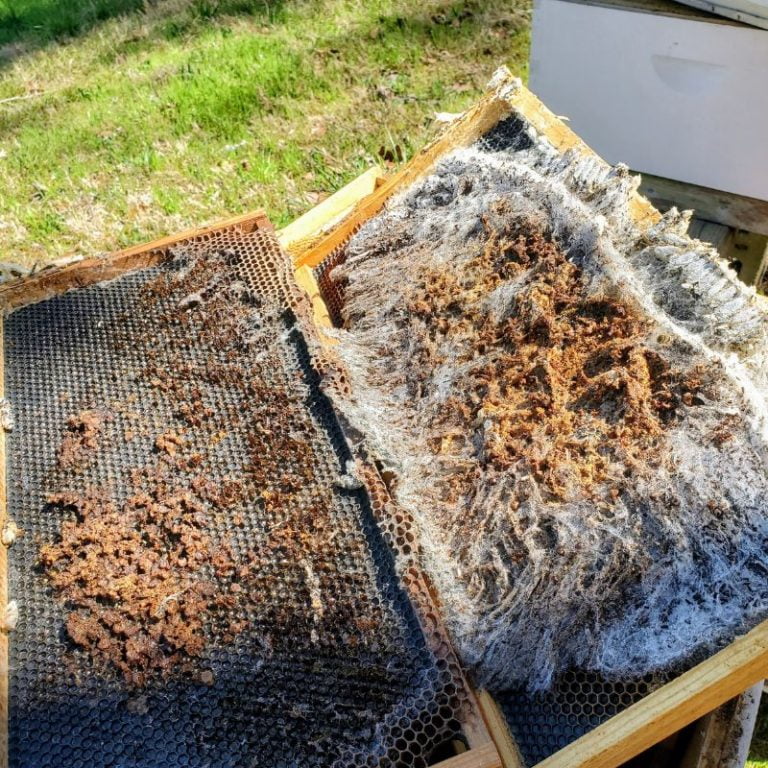
Equipment Damage Is Most Commonly Caused By
Wax moths & Moth larvae
Mice and rodents
Raccoons, Possums, Bears
Rain/Humidity
Each of these poses a unique threat to beekeepers and our beekeeping equipment, for which we must account.
Wax Moths In Beekeeping Equipment
As one of the most common pests for beekeepers to contend with when storing beekeeping equipment, the wax moth is responsible for destroying an untold number of valuable comb-filled frames. The adult wax moth flies onto the comb-filled frames to lay its eggs in them. When those eggs hatch into larvae, the larvae will seek out any pollen or bee cocoons inside the cells of the comb, destroying all the cells and leaving behind a webby mess.
This is why the darker brood comb, made dark from the bee cocoons in the cells, is most at risk from the wax moth. A lighter comb, which is clean at the time of storage and has only had liquid honey stored in it, does not suffer the same level of risk, but it’s still better to protect it than lose it. These things are the worst and cause the most damage in the least amount of time.
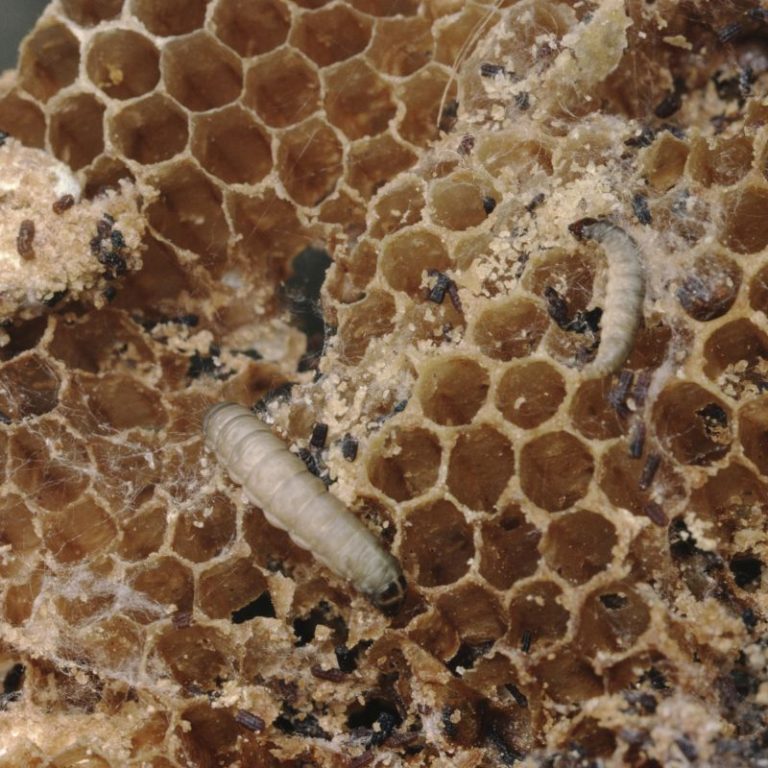
Mice In Beekeeping Equipment
Another highly common pest for overwintered equipment is the humble mouse. Unlike the wax moth, the mouse is not really interested in your comb itself or what is left behind in it. Instead, the issue with mice comes from the damage they cause while crawling around inside your supers and the droppings, hair, and other refuse left behind when they leave.
Mice in winter are searching for warmth and protection, and your stored supers provide the perfect conditions for them. We don’t want any mouse droppings inside our honey supers when it comes time to put them on the following year, so it’s always important to prepare for the possibility of rodents as we are planning our storage strategy for the winter. It’s not common to find mice in your beekeeping equipment, but it happens most often in an area near woods and stored equipment or equipment where the colony has died.

Small Hive Beetles
While certainly one of the more damaging pests for southern beekeepers during the active season, the small hive beetle doesn’t pose as big a threat to properly stored equipment over the winter. To ensure they don’t cause any problems, just be sure your frames are dry without leftover honey. As long as there are no valuable resources left behind for them, beetles will have no reason to bother your frames.
Clean Your Beekeeping Equipment
It should be obvious that honey can attract unwanted pests to places we’d rather them not be. Both bees and beekeepers spend enough time and energy protecting the stuff to know that much. But don’t forget about wax comb, pollen and nectar too. Any of these substances left on exposed equipment may attract pests over winter.
After a honey harvest, rather than hand washing with water, it is common to let the bees clean your empty frames for you. If you wish to let your bees clean for you, place a super full of empty frames on top of the inner cover and under the outer cover of one of your strong hives. Placing the supers over the inner cover is supposed to prevent the bees from building or filling any comb, but not all have succeeded with this method. It may take a few days to a week to clean off all of the frames but pay close attention to them to ensure they aren’t being refilled.
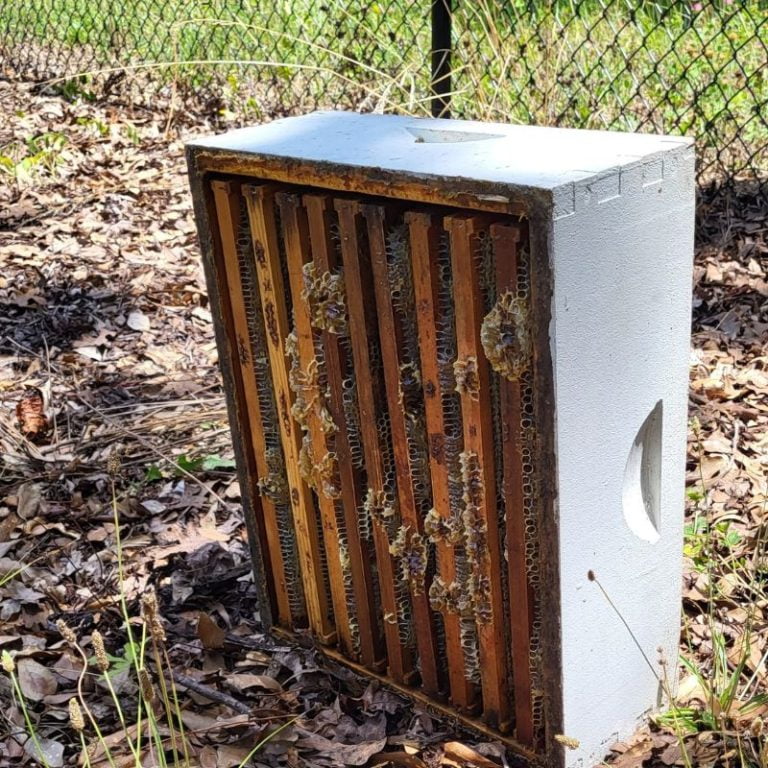
Another way that we like to get the sticky honey out of your hives is to place the boxes with the frames outside. In short order, area bees, wasps, and hornets will find the boxes, and it will start a feeding frenzy. The insects will carry off any sticky or leftover honey and take it back to their colony. If you do this, it will take a couple of days, and be aware a cloud of bees will form around the honey boxes for days. So don’t do it where you will be walking around. Just make sure you stack your honey boxes like this so that wax moths, beetles, or rain doesn’t start collecting in the comb and causing problems.
How To Store Supers, Bee Boxes, And Drawn Comb
Empty supers, bee boxes, bottom boards, inner covers, and telescoping covers should always be stacked neatly to keep this equipment safe. However, the main concern for beekeepers with winter storage is protecting drawn comb because that will be the most attractive thing for potential pests.
You can stack supers with empty drawn comb frames inside with the boxes either directly on top of each other and in-line or turned and offset to allow air to flow through them. Which method is best for you depends on the main challenges of your area and the options your bee yard and beekeeping storage setup have available.
In cold climates far enough North which experience sub-zero winters, wax moths and small hive beetles are primarily controlled by winter itself. You can safely store your equipment in a stack exposed to the cold temperatures and allowed to freeze, offering a suitable method of controlling the main pest issues of small hive beetles and moths. When storing like this, the freezing temperatures, airflow, and light on the comb will work together to protect the comb.

Feeding Bees During the Winter
Winter can be tough for bees. They can’t find much food and need extra help from us, the beekeepers. In this post, we’re going to
What Do Bees Do In The Winter?
One other thing to note is all of the following methods work well for purely honeycomb frames, but if your bees have raised any brood in the wax combs or you are attempting to store empty brood comb in brood boxes, storage is a bit of a different issue. Brood comb is usually found in the central lower sections of the hive, while honeycomb is found surrounding the brood comb and above it. When any comb is first created, it all appears clean and white. Honeycomb will retain this white to yellowish color while brood comb will darken with each generation due to the build-up of cocoons on the inside walls as well as soil and pollen particles which build up over time.
If only honey has been stored in the cells, the comb will not get dark. It’s the brood comb that gets darker and darker over the years.
Brood frames are particularly irresistible to wax moths, and the method you use when storing brood frames is more important. An open stack that uses light to reduce moth pressure is ineffective at protecting brood frames because moths are often willing to brave the light and open air to get to the brood comb. The use of light and air is helpful, but it isn’t full proof. Be sure to use moth ice crystals or freezing techniques for any brood comb you have.
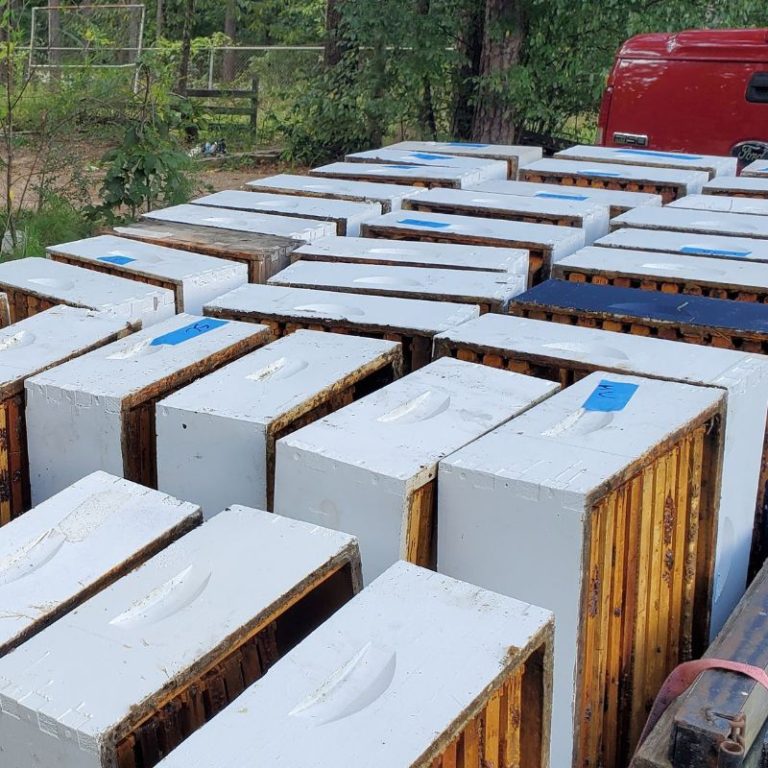
Closed Stack / Stack And Treat
If you have an enclosed shed environment without much light to help you, it will be essential to use moth ice crystals in your equipment stack to repel moths and prevent them from destroying your frames.
A good method for using moth ice crystals is to stack your supers flat on the floor with a piece of cardboard under them to act as a sort of vapor gasket. Then stack them in line or a “closed stack” to keep the moth crystal vapor inside the column you are creating with your supers. You will place a layer of newspaper between every 3 or 4 supers with some moth ice crystals on top. It may also help to use a queen excluder under the newspaper to provide more support.
Depending on how well your boxes fit together, it may be necessary to tape up the seams in your stack to reduce the amount of vapor that escapes. If your boxes fit together pretty tight, it may not be necessary to tape them up, but if there are gaps in your seams, it is probably a good idea to do so. Whether you tape up the seams or not, it’s always a good idea to place large plastic bags over the top of your stack to slow and contain the vapor’s dissipation.
Be sure to allow equipment stored with moth crystals this way to air out at least a few days before you intend to use it in the spring or until the smell dissipates completely.
The main downside of storing boxes stacked in line is the possibility of mold growth from humidity issues. If your storage space doesn’t have ventilation or climate control, a closed stack of boxes may provide the perfect environment for mold to grow and cost you some time and clean-up work in the spring. If humidity is an issue in your area, an open stack may be a better solution.
It’s not wise to spray down equipment with water before storing it. If you do, you have to let it dry completely before putting away for the winter. The water on the comb or in the boxes will start to cause the comb to mold.
Open Stacked Beekeeping equipment
If you are not storing your boxes in a climate-controlled environment and humidity is a possible issue, it is wise to stack them offset 90 degrees so that air and light can pass through. The airflow will help prevent mold damage to your boxes, while the light this method lets in will reduce wax moths’ interest in inhabiting the space.
Beekeepers will often utilize this method with open sheds that have lots of light available. These usually have either windows or are enclosed with chain links or wire netting to protect the equipment from larger animals. This method does not work well with the use of moth crystals as all of the vapor from the crystals will dissipate into the surrounding air, but if you have enough light and you are not storing brood comb, the open stacking method may be the right option for you.
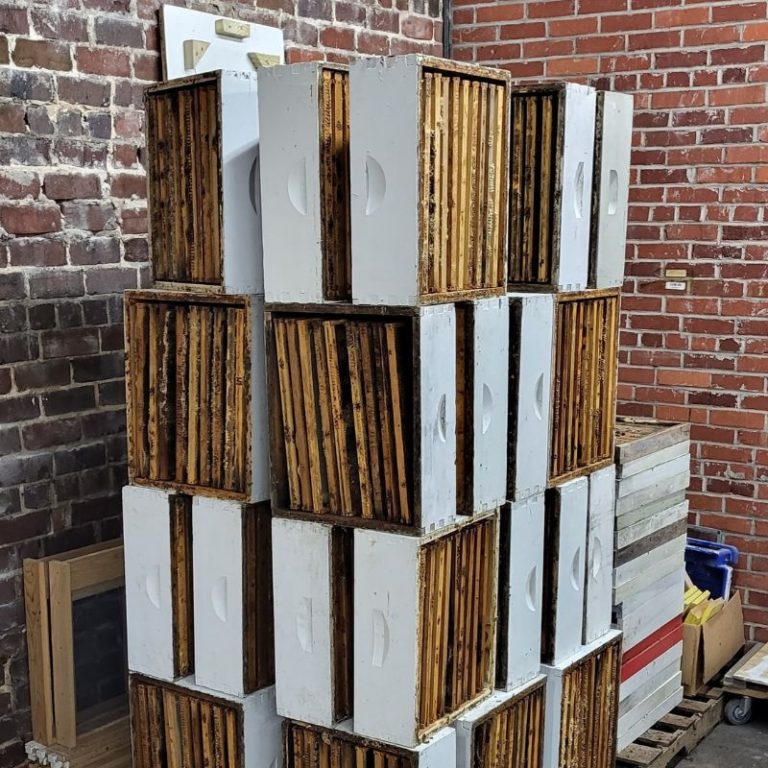
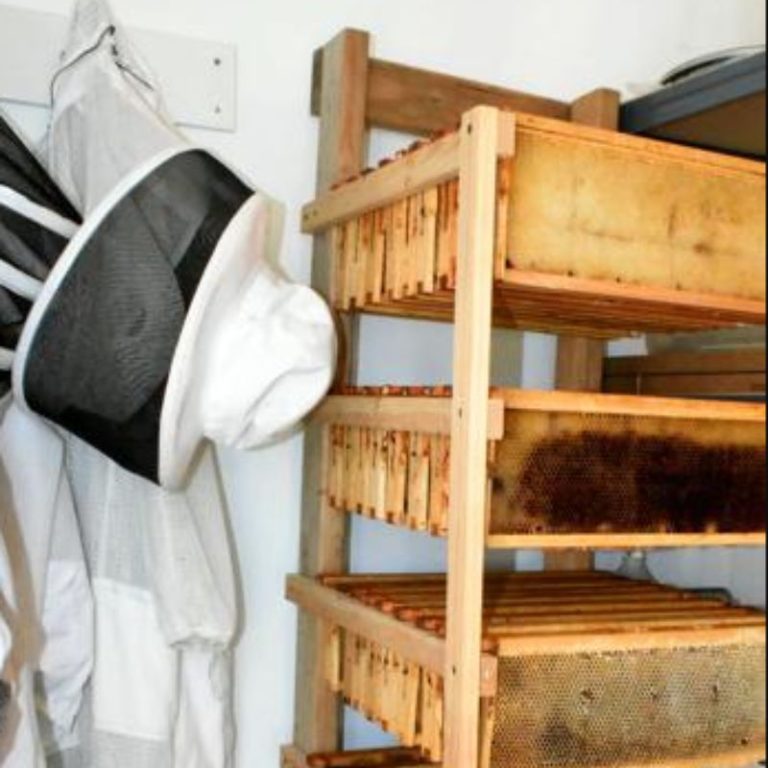
Frame Rack for storing frames
One alternative method to stacking supers with frames is building a rack for your empty combs themselves. These racks are built vertically with many rows for storing frames directly on the racks and exposed to both light and air. This solution works well as long as the frames get enough light in the environment they are stored.
The challenge, however, is keeping rodents and larger animals from the frames when you store them in an exposed manner. Be sure to use the rack method in a chain link or well-lit enclosure to protect the exposed comb from these larger animals and rodents.
Freezing Bee Boxes and Frames
Freezing is likely the most effective overall storage method if you have the equipment and can do so. Freezing a lot of supers can be cost-prohibitive depending on the size of your operation. Walk-in freezers with adequate space are an expensive investment, and a chest freezer only stores so many supers. One method of maximizing the potential of using a freezer is to freeze supers one at a time and then store them traditionally in stacks. This way, you benefit from killing off any wax moth and small hive beetle larvae that may be present at the time of storage.
Of course, beekeepers are often left with just a few frames of honey after an extraction. Storing individual frames of honey and partial honey/pollen frames works well in a freezer too. When frozen, they are protected from moths, hive beetles, and other pests, and you can feed them back to the same colony or a weaker colony in late winter or early spring. Just let the frames thaw before adding them back into any of your hives.
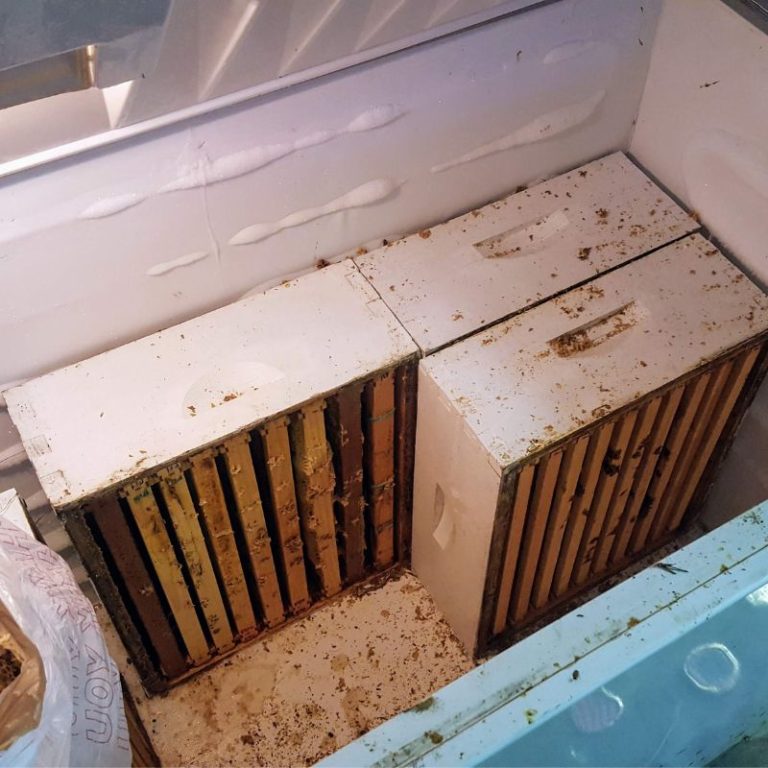
Studies show the temperature and time required to kill wax moth larvae and small hive beetle larvae is 20 degrees F for 4.5 hours or 5 degrees F for 2 hours. If you have the time, it’s best to leave frames in the freezer overnight before moving them to more permanent storage like a stack, rack, or storage bin. Be sure to allow any frozen comb to defrost fully before putting it in a bag or enclosed container. The frost on the comb will melt into the water, which will then cause mold to form inside an enclosed space.
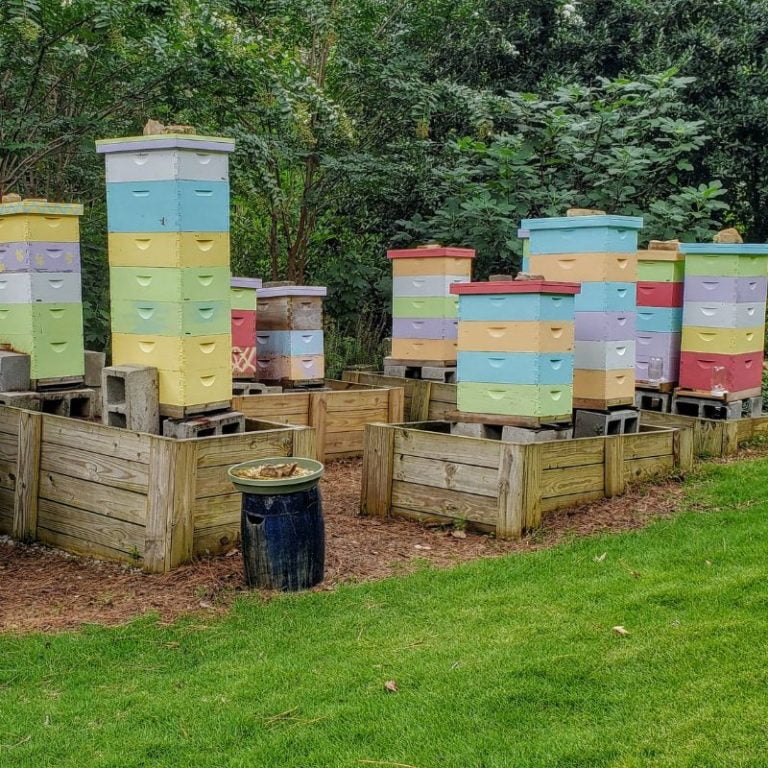
Storing Equipment Directly on a Colony
If you have strong hives you are working with, it is possible to store empty supers back on the hive they came from. Honey bees are often better at preventing mold and moths than we are. The main problem with this method, particularly in the south, is this excess space creates a breeding ground for the small hive beetle. It’s important not to provide too much space for a colony during the winter to keep beetles under control. Because of this, it is best to reserve the storage of supers directly on hives for strong colonies.
Suppose you end up with just a few leftover frames from an extraction before winter, and you cannot freeze these frames. In that case, it is often the best idea to give these directly to an overwintering colony for their use and make sure they have enough honey rather than attempting to keep wet frames stored another way. Because you have consolidated your hives for winter, you will not have extra boxes for these honey frames. Instead, a good strategy is to set these frames out in your bee yard to be robbed out. This way, your bees will be able to store this extra honey for winter within their newly consolidated hives.
Wax Cappings And Burr Comb Storage
During any extraction and equipment clean-up, lots of beeswax and propolis is usually scraped up by the hive tool and collected as part of the process. Both of these products can be separated and stored for use along with your hives’ other resources. To separate propolis from your wax scrapings, soak the scrapings in water, and the propolis will sink while the wax floats. Once separated, the propolis can be dried and stored in jars.
Collected burr comb and wax cappings are best stored after melting them down first. After rendering this way, wax moths will no longer be interested in the wax, although mice and rodents may still try to eat it if there is no other food available. Any unmelted cappings should be treated like comb frames and stored in a sealed bucket with a gasket on it or in a freezer until you can get to melting it down.
You can store melted and rendered beeswax just about anywhere you have some space. If mice become a problem, you can protect your rendered wax by storing it in containers in the same location as your stacked supers and with a mousetrap nearby for protection.
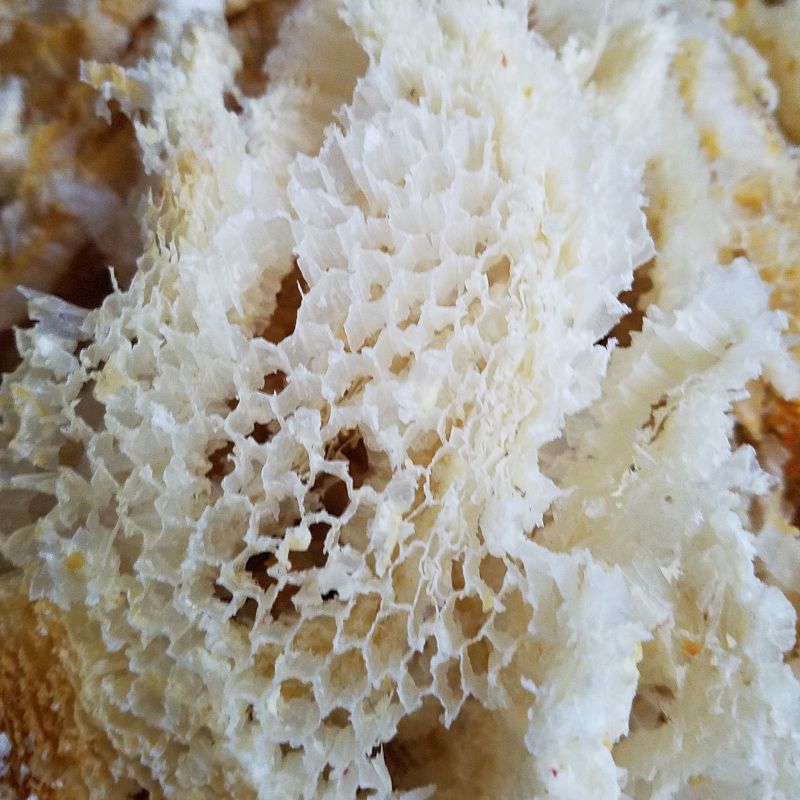
One excellent method of rendering beeswax is a solar wax melter. These use the sun’s power, directed through glass or clear polycarbonate surface and onto the wax to raise the temperature inside and melt the wax while leaving behind any larvae, cocoons, or other debris. After learning about this energy-free way of melting and cleaning wax, filtering, and processing beeswax has become more manageable.
Unfortunately for most of us in North America, solar wax melters work better in summer when the heat they generate isn’t immediately lost to the surrounding air. Any wax needing to be melted in winter will likely require its own heat source like a crockpot or double boiler in order to work well.
Special Considerations
Mice
Ralph Waldo Emerson said, “Build a better mousetrap, and the world will beat a path to your door.”
Luckily, we don’t need a better mousetrap as the old ones work just fine. Whichever method you use to store them, if mice are getting into your supers, it’s a good idea to surround your equipment stacks with mousetraps on each side. This old-fashioned solution gets the job done and doesn’t cost much either. Additionally, those pollen patties you likely already have laying around will work great as mouse bait too. Trust us….
This is the mouse trap that we use when mice are getting into our pollen patties. The are easy to set and do the job quickly.

Wax Moths & Wax Moth Larvae
Wax moths love a dark place, and because of this, it is critical to use moth crystals when stacking supers in closed environments. Moth crystals start as a solid that, instead of passing through a liquid state, converts directly into a gaseous state through a process called sublimation.
A product called Para Moth is one standard solution, but we have found a better version of the same chemical to be Enoz Moth Ice Crystals. These ice crystals are a bit less grainy than Para Moth and easy to use in stacked supers. They come in 16oz and larger sizes, and it requires approximately 1 ounce of the crystals for every 3, 10-frame mediums or every 2, 10-frame deep boxes, so plan and purchase accordingly.
Whatever you do, do NOT use regular mothballs in your supers. These are made from a chemical called naphthalene. This chemical will leave behind a residue that is not safe for human consumption, and you should not use it in beekeeping equipment. The packaging looks very similar, but the product is different than from what is safe for bees. Instead, be sure that whatever you use is made of paradichlorobenzene only, as this chemical will leave behind no residue in your equipment and is safe to use as long as you air out your stored equipment before use.
Another option beekeepers choose for moth control is placing a bug zapper in the storage space you use for wax frames for an extra layer of protection. Bug zappers are a safe and effective, chemical-free method of suppressing moth pressure on your stored frames.
Moving Cold Or Frozen Beeswax Frames
All wax becomes brittle when it gets cold, and honeycomb is no different. It’s crucial to take care when trying to move cold or frozen frames. Shaking or hitting something with a frozen frame can cause the wax to dislodge and break away from the plastic foundation. It’s a good practice to allow honeycomb to rise to room temperature before moving it too far or shaking it much but if you can’t wait, be sure to use extra care during the process.
Winter Is About Protecting Our Investments
There is no “one thing” we do when preparing our equipment for winter storage that is full proof. There will always be many considerations to consider and adapt to our circumstances. Still, with these storage methods and practices in your toolbox, you’ll be better prepared to protect the investments you have made in your equipment. Proper storage procedures are just one of the many ways a beekeeper can put in the work needed now to save far more work or expense later on. Now it’s onto taking care of your other beekeeping tools and beekeeping clothes like cleaning your bee suit.



